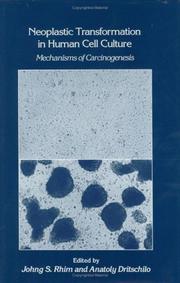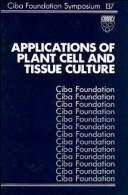| Listing 1 - 9 of 9 |
Sort by
|

ISBN: 0896032272 Year: 1991 Publisher: Totowa, N.J. Humana Press
Abstract | Keywords | Export | Availability | Bookmark
 Loading...
Loading...Choose an application
- Reference Manager
- EndNote
- RefWorks (Direct export to RefWorks)

ISBN: 0897662067 0897662075 9780897662062 9780897662079 Year: 1983 Volume: 407 Publisher: New York, N.Y. New York Academy of Sciences
Abstract | Keywords | Export | Availability | Bookmark
 Loading...
Loading...Choose an application
- Reference Manager
- EndNote
- RefWorks (Direct export to RefWorks)
Toxicology --- Toxicity testing --- Cell culture --- Congresses --- -Toxicity testing --- -Poisons --- Toxicological testing --- Toxicology testing --- Toxicology, Experimental --- Cultures (Biology) --- Cytology --- Testing --- Technique --- Cytological technics --- Mutagenicity tests --- Congresses. --- -Congresses --- Toxicity testing - Congresses --- Cell culture - Congresses --- Cellules --- Toxicologie
Book
ISBN: 0845118021 9780845118023 Year: 1987 Volume: 3 Publisher: New York Liss
Abstract | Keywords | Export | Availability | Bookmark
 Loading...
Loading...Choose an application
- Reference Manager
- EndNote
- RefWorks (Direct export to RefWorks)
Phytohistology. Phytocytology --- Plant cell culture --- Plant micropropagation --- Plant tissue culture --- Congresses --- -Plant micropropagation --- -Plant tissue culture --- -#ABIB:atte --- Tissue culture --- In vitro plant propagation --- Micropropagation, Plant --- Plant propagation --- Plants --- Vegetative propagation --- Cell culture --- In vitro --- Micropropagation --- Congresses. --- #ABIB:atte --- Plant cell culture - Congresses --- Plant micropropagation - Congresses --- Plant tissue culture - Congresses
Book
ISBN: 0126733503 9780126733501 Year: 1974 Publisher: London Academic press
Abstract | Keywords | Export | Availability | Bookmark
 Loading...
Loading...Choose an application
- Reference Manager
- EndNote
- RefWorks (Direct export to RefWorks)
Plant tissue culture --- Plant cell culture --- Congresses --- -Plant tissue culture --- -58.083 --- Tissue culture --- Cell culture --- Special tecgniques for preparation & preliminary treatment of specimens for experiment and observation. Cultures. Sterilization, etc. --- Conferences - Meetings --- 58.083 --- Special tecgniques for preparation & preliminary treatment of specimens for experiment and observation. Cultures. Sterilization, etc --- Plant tissue culture - Congresses --- Plant cell culture - Congresses

ISBN: 0471918865 9780471918868 Year: 1988 Volume: 137 Publisher: Chichester, Sussex, UK ; New York : Wiley,
Abstract | Keywords | Export | Availability | Bookmark
 Loading...
Loading...Choose an application
- Reference Manager
- EndNote
- RefWorks (Direct export to RefWorks)
Applications of Plant Cell and Tissue Culture Chairman: Y. Yamada 1988 Interest in all aspects of plant cell and tissue culture is expanding rapidly as the technologies available improve and the commercial potential of these processes becomes apparent. This book covers basic plant physiology and cytology and extends to the practical exploitation of plants, both as crops per se and as sources of useful compounds produced as secondary metabolites. The reduction of plants to single cells or tissues that can be maintained in culture facilitates their manipulation by the techniques of molecular biology. Genes encoding desirable traits, for example herbicide or pathogan resistance or early flowering, can be introduced into domesticated crops by transformation of normal plant cells using a natural vector such as Agrobacterium, by the uptake of DNA into protoplasts using techniques developed for animal cells, or by direct injection of DNA into intact cells with cell walls. Application of these technologies to forest trees is especially important because the long lifespan of these species makes their improvement by conventional breeding programmes very slow. Problems of commercial exploitation considered include the storage of genetically engineered material until progeny evaluation has been completed, the stability of traits in culture, and the feasibility of adapting laboratory methods to large-scale production plants. There is also some discussion of the sociolegal aspects of genetic engineering of crop plants, and of the difficulties of marketing 'natural' compounds produced by cells under artificial conditions. Related Ciba Foundation Symposia: No 97 Better crops for food Chairman: E. A. Bell 1983 ISBN 0 272 79729 4 No 133 Plant resistance to viruses Chairman: B. D. Harris 1987 ISBN 0 471 91263 8
Plant micropropagation --- Plant Molecular Biology --- Plant Molecular Biology. --- Plant biotechnology --- Plant cell culture --- Plant tissue culture --- Congresses --- Basic Sciences. Molecular Biology --- Congresses. --- Plant propagation --- In vitro --- Plant biotechnology - Congresses --- Plant cell culture - Congresses --- Plant tissue culture - Congresses --- Plant micropropagation - Congresses --- CELLS, CULTURED --- PLANTS --- TISSUE CULTURE --- GENETICS --- GENETIC CODE --- GENETIC VECTORS --- CONGRESSES
Book
ISBN: 1402096453 9786612824692 1282824694 1402096461 Year: 2009 Publisher: Dordrecht ; London : Springer,
Abstract | Keywords | Export | Availability | Bookmark
 Loading...
Loading...Choose an application
- Reference Manager
- EndNote
- RefWorks (Direct export to RefWorks)
Animal cell technology is a growing discipline of cell biology which aims not only to understand structures, functions and behaviors of differentiated animal cells, but also to ascertain their abilities to be used for industrial and medical purposes. The goal of animal cell technology includes the clonal expansion of differentiated cells, the optimization of their culture conditions, modulation of their ability to produce proteins of medical and pharmaceutical importantance, and the application of animal cells to gene therapy, artificial organs and the production of functional foods. This volume gives the readers a complete review of the present state-of-the-art and will be useful for those working in either academic environments or in the biotechnology and pharmaceutical sectors, particularly cell biologists, biochemists, molecular biologists, immunologists, biochemical engineers and all other disciplines related to animal cell culture.
Animal cell biotechnology -- Congresses. --- Cell culture -- Congresses. --- Animal cell biotechnology --- Cell culture --- Complex Mixtures --- Publication Formats --- Biological Science Disciplines --- Cells --- Culture Techniques --- Technology --- Publication Characteristics --- Natural Science Disciplines --- Technology, Industry, and Agriculture --- Chemicals and Drugs --- Anatomy --- Clinical Laboratory Techniques --- Disciplines and Occupations --- Technology, Industry, Agriculture --- Investigative Techniques --- Analytical, Diagnostic and Therapeutic Techniques and Equipment --- Congresses --- Biological Products --- Biotechnology --- Cell Culture Techniques --- Cells, Cultured --- Mechanical Engineering --- Engineering & Applied Sciences --- Bioengineering --- Chemistry. --- Biotechnology. --- Food --- Cell biology. --- Biomedicine general. --- Cell Biology. --- Food Science.
Book
ISBN: 9048134188 9786612924736 1282924737 9048134196 Year: 2010 Publisher: New York : Springer,
Abstract | Keywords | Export | Availability | Bookmark
 Loading...
Loading...Choose an application
- Reference Manager
- EndNote
- RefWorks (Direct export to RefWorks)
It has been predicted that nearly half of all human proteins are glycosylated indicating the significance of glycoproteins in human health and disease. For example, the glycans attached to proteins have emerged as important biomarkers in the diagnosis of diseases such as cancers and play a significant role in how pathogenic viruses gain entry into human cells. The study of glycoproteins has now become a truly proteomic science. In the last few years, technology developments including in silico methods, high throughput separation and detection techniques have accelerated the characterization of glycoproteins in cells and tissues. Glyco-engineering coupled to rapid recombinant protein production has facilitated the determination of glycoprotein structures key to exploring and exploiting their functional roles. Each chapter in this volume is written by experts in the field and together provide a review of the state of the art in the emerging field of glycoproteomics.
Animal cell biotechnology -- Congresses. --- Cell culture -- Congresses. --- Tissue culture -- Congresses. --- Cell culture --- Animal cell biotechnology --- Culture Techniques --- Cells --- Biological Science Disciplines --- Animals --- Technology --- Cell Culture Techniques --- Biotechnology --- Cells, Cultured --- Animal Population Groups --- Clinical Laboratory Techniques --- Anatomy --- Eukaryota --- Natural Science Disciplines --- Technology, Industry, and Agriculture --- Technology, Industry, Agriculture --- Organisms --- Disciplines and Occupations --- Investigative Techniques --- Analytical, Diagnostic and Therapeutic Techniques and Equipment --- Biology --- Mechanical Engineering --- Bioengineering --- Cytology --- Engineering & Applied Sciences --- Health & Biological Sciences --- Agricultural biotechnology --- Medicine. --- Biomedicine. --- Biomedicine general. --- Clinical sciences --- Medical profession --- Human biology --- Life sciences --- Medical sciences --- Pathology --- Physicians --- Health Workforce --- Biomedicine, general. --- Medicine --- Biomedical Research. --- Research. --- Biological research --- Biomedical research
Book
ISBN: 0897660870 0897660889 9780897660884 9780897660877 Year: 1980 Volume: 349 Publisher: New York, N.Y. New York Academy of Sciences
Abstract | Keywords | Export | Availability | Bookmark
 Loading...
Loading...Choose an application
- Reference Manager
- EndNote
- RefWorks (Direct export to RefWorks)
Oncology. Neoplasms --- Gastroenterology --- Carcinogenesis --- Liver cells --- Cell transformation --- Cell culture --- Congresses --- Differentiation --- Carcinogens. --- Cell Differentiation. --- Cell Transformation, Neoplastic. --- Cells, Cultured. --- Liver Neoplasms, Experimental --- Liver --- -Cell culture --- -Cell transformation --- -Liver cells --- -#Lilly --- Hepatic cells --- Hepatocytes --- Cells --- Culture alteration (Cytology) --- Transformation of cells --- Tissue culture --- Cultures (Biology) --- Cytology --- Cancer --- Oncogenesis --- Pathogenesis of cancer --- Tumorigenesis --- Pathology --- Genetic toxicology --- Cultured Cells --- Cell, Cultured --- Cultured Cell --- Organ Culture Techniques --- Coculture Techniques --- Cell Culture Techniques --- Culture Techniques --- Human Umbilical Vein Endothelial Cells --- Neoplastic Cell Transformation --- Transformation, Neoplastic Cell --- Tumorigenic Transformation --- Neoplastic Transformation, Cell --- Cell Neoplastic Transformation --- Cell Neoplastic Transformations --- Cell Transformations, Neoplastic --- Neoplastic Cell Transformations --- Neoplastic Transformations, Cell --- Transformation, Cell Neoplastic --- Transformation, Tumorigenic --- Transformations, Cell Neoplastic --- Transformations, Neoplastic Cell --- Transformations, Tumorigenic --- Tumorigenic Transformations --- Cell Line, Transformed --- Differentiation, Cell --- Cell Differentiations --- Differentiations, Cell --- Embryo, Mammalian --- Gene Expression Regulation --- Cell Lineage --- Oncogens --- Tumor Initiators --- Tumor Promoters --- Initiators, Tumor --- Promoters, Tumor --- Benzidines --- chemically induced. --- cytology. --- -Congresses --- Technique --- Pathogenesis --- Carcinogens --- Cell Differentiation --- Cells, Cultured --- Cell Transformation, Neoplastic --- #Lilly --- Differentiation&delete& --- chemically induced --- cytology --- Carcinogen --- Oncogen --- Tumor Initiator --- Tumor Promoter --- Initiator, Tumor --- Promoter, Tumor --- Carcinogenesis - Congresses --- Liver cells - Differentiation - Congresses --- Cell transformation - Congresses --- Cell culture - Congresses

ISBN: 0879691212 0879691255 9780879691257 9780879691219 Year: 1979 Volume: 5 Publisher: Cold Spring Harbor Cold Spring Harbor laboratory
Abstract | Keywords | Export | Availability | Bookmark
 Loading...
Loading...Choose an application
- Reference Manager
- EndNote
- RefWorks (Direct export to RefWorks)
Hormones --- Cell culture --- Cell differentiation --- Growth factors --- Cellules --- Facteurs de croissance --- Physiological effect --- Congresses --- Effets physiologiques --- Congrès --- Culture --- Différenciation --- -Cell culture --- -Cell Differentiation. --- Cells, Cultured. --- Growth Substances. --- Hormones. --- -Growth factors --- -Cell growth factors --- Cellular growth factors --- Growth peptides --- Growth promoting substances --- Growth substances --- Peptide growth factors --- Peptide regulatory factors --- Polypeptide growth factors --- Cytokines --- Peptides --- Cell fate specification --- Cell specification --- Cells --- Differentiation of cells --- Fate specification of cells --- Specification of cells --- Morphogenesis --- Hormone --- Hormone Receptor Agonists --- Agonists, Hormone Receptor --- Receptor Agonists, Hormone --- Endocrine Glands --- Mitogens, Endogenous --- Endogenous Mitogens --- Agricultural Inoculants --- Cultured Cells --- Cell, Cultured --- Cultured Cell --- Organ Culture Techniques --- Coculture Techniques --- Cell Culture Techniques --- Culture Techniques --- Human Umbilical Vein Endothelial Cells --- Differentiation, Cell --- Cell Differentiations --- Differentiations, Cell --- Embryo, Mammalian --- Gene Expression Regulation --- Cell Lineage --- Cultures (Biology) --- Cytology --- Catecholamines --- Endocrine glands --- Endocrinology --- Secretion --- -Congresses --- Differentiation --- Fate specification --- Specification --- Technique --- Conferences - Meetings --- -Physiological effect --- Congrès --- Différenciation --- Cell Transformation, Neoplastic --- Hematopoietic Stem Cells --- Hematopoietic System --- Hematopoietic system --- Myeloproliferative disorders --- Cancérogenèse --- Cell Differentiation. --- Cell Transformation, Neoplastic. --- Hematopoietic Stem Cells. --- Hematopoietic System. --- -Cell differentiation --- -Hematopoietic system --- -Myeloproliferative disorders --- -Myeloproliferative syndrome --- Bone marrow --- Hemopoietic system --- Oncogenesis --- Pathogenesis of cancer --- Tumorigenesis --- Genetic toxicology --- Hematopoietic Systems --- System, Hematopoietic --- Hematopoietic Progenitor Cells --- Colony-Forming Units, Hematopoietic --- Progenitor Cells, Hematopoietic --- Stem Cells, Hematopoietic --- Cell, Hematopoietic Progenitor --- Cell, Hematopoietic Stem --- Cells, Hematopoietic Progenitor --- Cells, Hematopoietic Stem --- Colony Forming Units, Hematopoietic --- Colony-Forming Unit, Hematopoietic --- Hematopoietic Colony-Forming Unit --- Hematopoietic Colony-Forming Units --- Hematopoietic Progenitor Cell --- Hematopoietic Stem Cell --- Progenitor Cell, Hematopoietic --- Stem Cell, Hematopoietic --- Unit, Hematopoietic Colony-Forming --- Units, Hematopoietic Colony-Forming --- Neoplastic Cell Transformation --- Transformation, Neoplastic Cell --- Tumorigenic Transformation --- Neoplastic Transformation, Cell --- Cell Neoplastic Transformation --- Cell Neoplastic Transformations --- Cell Transformations, Neoplastic --- Neoplastic Cell Transformations --- Neoplastic Transformations, Cell --- Transformation, Cell Neoplastic --- Transformation, Tumorigenic --- Transformations, Cell Neoplastic --- Transformations, Neoplastic Cell --- Transformations, Tumorigenic --- Tumorigenic Transformations --- Cell Line, Transformed --- Carcinogenesis --- Cell Differentiation --- Myeloproliferative syndrome --- Hematopoiesis --- Diseases --- Cells, Cultured --- Growth Substances --- Physiological effect&delete& --- congresses --- Congresses. --- Cancérogenèse --- congresses. --- Cell culture - Congresses --- Cell differentiation - Congresses --- Growth factors - Congresses --- Hormones - Physiological effect - Congresses --- Cell Differentiation - congresses --- Hematopoietic System - congresses --- Cell Transformation, Neoplastic - congresses --- Carcinogenesis - Congresses --- Hematopoietic system - Congresses --- Myeloproliferative disorders - Congresses
| Listing 1 - 9 of 9 |
Sort by
|

 Search
Search Feedback
Feedback About UniCat
About UniCat  Help
Help News
News